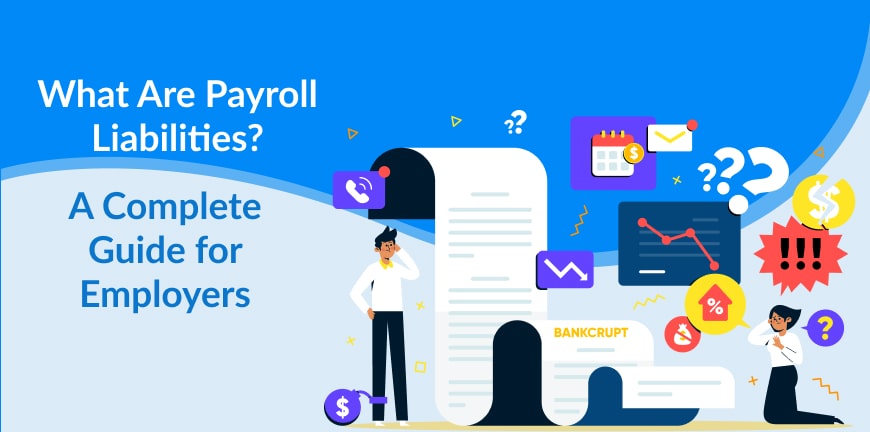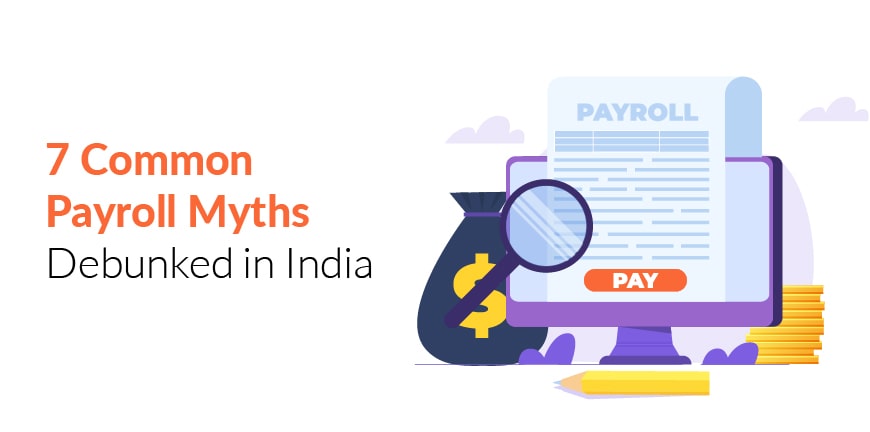
10 Key Healthcare Staffing Challenges and Solutions
13/05/2025
Tech Talent Spree in India: What It Means for Freshers and Professionals
13/05/2025- What are Payroll Liabilities? Definition & Meaning
- What is the Importance of Payroll Liabilities?
- What are the 4 Types of Payroll Liabilities?
- How to Track Payroll Liabilities?
- How to Pay Payroll Liabilities?
- What are the Common Mistakes to Avoid?
- What are the Payroll Liabilities Best Practices?
- Are You Looking for a Payroll Partner?
- Frequently Asked Questions (FAQs)
Companies, whether startups or market leaders, are obligated to make certain payments towards employee welfare, government programs, and other agencies to prevent operational disruptions and meet compliance requirements. Payroll liabilities are one such obligation that employers must allocate in their financial budgeting and settle before the due date. Let’s discuss and gain more insights into the payroll liabilities definition, importance, types, tracking, common mistakes, and best practices.
What are Payroll Liabilities? Definition & Meaning
The payroll liabilities definition states that ” It is the pending amount that is overdue and needs to be paid by employers to employees, government authorities, insurance carriers, and other organisations after the payroll process is carried out. Some of the key payroll liability components include:
- Pending wages owed to employees.
- Payroll taxes withheld.
- Voluntary deductions
- Employee bonuses and incentives
- Employee Benefits contributions
Employers must ensure there are no payroll liabilities, and all payments related to payroll are settled within the prescribed deadline, according to payroll liabilities’ meaning and definition described in the payroll regulations. Any violations related to payroll may result in penalties and lawsuits, which can damage the brand’s reputation and increase the expenses.
What is the Importance of Payroll Liabilities?
As per the payroll liabilities definition, it is clear that the employer must manage payroll tax liabilities and other pending payments diligently to prevent penalties and legal hassles.
The reasons that make employer liabilities payroll management crucial are:
- Payroll liabilities must be factored in while preparing budgets and cash flow projections. The companies must have sufficient funds to meet the obligations related to the different payroll-related liabilities.
- The current liabilities and payroll accounting play a crucial role in maintaining profitability and managing employee costs.
- Employer liabilities payroll such as taxes, employee benefits, bonuses, and overtime pay, are part of compliance requirements, and fulfilling them is imperative to prevent penalties and legal hassles from the governing authorities.
- Companies must settle the payroll liabilities on time, improve employee morale, and maintain brand reputation.
- Understanding and effectively managing payroll liabilities can help companies streamline their business operations and reduce the risks of non-compliance.
What are the 4 Types of Payroll Liabilities?
The different payroll liabilities (payroll liabilities examples) applicable in India include:
1. Employee compensation
Employees are entitled to receive bonuses, incentives, and reimbursements for their contributions to the business growth, and employers must settle them within a short period to avoid escalations and maintain employee morale.
2. Payroll tax liabilities
Employers must withhold certain taxes from the employee’s salary, such as TDS, professional tax, etc., and remit them to the government within the set due date to avoid penalties.
3. Paid Time Off
Employers provide paid time off leaves to employees, which can be used for personal work. However, if the employee has not used the PTO for any reason, it is also considered a payroll liability, and the employer must pay the dues in case the employee leaves the company.
4. Voluntary Deductions
Employers perform voluntary deductions such as EPF, EPS, ESI, and medical insurance to help employees manage their health and save some of their earnings in the form of retirement funds, etc. This is a crucial payroll liability that employers must manage effectively to help employees make a smooth transition into their retired life.
How to Track Payroll Liabilities?
Overlooking payroll liabilities is a serious possibility since they are settled at a future date. Employer liabilities payroll must be taken into account when making plans for the yearly budget, and payments must be made within deadlines to prevent legal problems. Therefore, tracking payroll liabilities becomes essential, and here are some steps that make tracking easier and more accurate:
- Implement an effective payroll management system or outsource the entire payroll responsibilities to a reliable payroll service provider like ALP Consulting.
- Store all the records related to payroll operations securely, verify payroll liabilities during the audit, and make arrangements for settling them.
- Use a payroll accounting software that automatically calculates the payroll liabilities and gives notifications about the due date.
- Open a separate bank account for managing payroll and tracking payroll liabilities.
How to Pay Payroll Liabilities?
Before settling the payroll liabilities, employers must accurately calculate the net amount to be paid. Here are the typical steps of calculating employer liabilities payroll:
- Calculate the gross total pay for each employee.
- Compute the payroll tax liabilities like TDS, professional tax, etc.
- Calculate the voluntary deductions like EPF, medical insurance, ESI, employee benefits, etc.
- Add up the payroll liabilities and maintain a balance sheet.
The payroll liabilities payment methods and deadlines will vary based on the locations and applicable regulations. Here are the main steps to make payments for payroll liabilities:
- Pay net wages to employees through an effective payroll management system and provide payslips with clear and accurate break up and income and deductions.
- Pay the taxes and social security contributions like EPF, ESI, gratuity, etc., to the respective government agencies through their official websites.
- Fill out all the necessary forms like Form 24Q, Form 16, etc., as a part of tax reporting.
What are the Common Mistakes to Avoid?
The common mistakes to avoid while managing payroll liabilities include:
1. Employee misclassification
Employee misclassification may lead to incorrect payment calculation, leading to overpayment and underpayment of salaries. This can affect the final payroll liability computation, resulting in penalties and non-compliance.
2. Incorrect pay
Sometimes, due to human error or wrong salary calculations, employees may receive incorrect payment, leading to a payroll error. If this is not fixed immediately, then the payroll liabilities calculations will also be affected, leading to serious consequences for the employer.
3. Inadequate tracking of working hours and overtime
Companies must implement an efficient attendance and working hours tracking system for accurate calculation of overtime payment. If the tracking is inadequate, then overtime payment calculations will be incorrect. Ultimately, the employees will end up being overpaid or underpaid, leading to wrong payroll liability calculation and employee dissatisfaction.
4. Missing deadlines
Typically, payroll liabilities must be settled at a later date, and hence, chances of missing deadlines are prevalent, especially with payroll taxes, bonuses, and incentives. This will affect both compliance and financial reporting, leading to brand reputation damage and negative employee experience.
5. Incomplete records and documentation
Without an automated payroll management system, relying solely on manual record-keeping can be a recipe for disaster. Payroll liabilities heavily depend on accurate payment records and documentation, as the final payroll liability calculation and settlement are done based on the payroll records.
What are the Payroll Liabilities Best Practices?
Managing payroll liabilities can be challenging, but with the right strategies and systematic approach, it is possible to reduce errors and improve efficiency. Some of the best practices for effective management of employer liabilities payroll include:
1. Keep track of the due dates for settling payroll liabilities
Different government agencies have different payment terms and deadlines for payroll liabilities. Companies must seek assistance from automation and technology to get reminders of the due dates and make auto payment arrangements with the help of a payroll management system.
2. Set up a separate bank account for payroll transactions
A dedicated bank account for payroll transactions can help employers keep track of expenses and future payroll liabilities in a streamlined manner. This arrangement will also help employers to use funds in the account only for payroll tasks and not for making payments for other business needs.
3. Maintain accurate payroll records
Companies must maintain accurate payroll records and documentation to ensure payroll liabilities are taken care of before the deadlines. Typically, an automated payroll management system creates payroll records in real time, but if it is not available, use electronic storage systems to maintain the payroll records securely, as they contain sensitive employee data.
Are You Looking for a Payroll Partner?
Managing payroll liabilities can be tricky and time-consuming, especially for companies with a large workforce spread across various geographical locations. Also, keeping a dedicated team for payroll management is expensive and can affect profitability. Therefore, partnering with an expert payroll management service provider can help streamline the payroll operations and take care of employer liabilities with relative ease.
ALP Consulting, a leading HR and outsourcing company, has nearly 30 years of expertise and experience in providing tailored payroll management solutions to startups and market leaders across India. Along with handling payroll operations, ALP will also take care of payroll liabilities and ensure payments are settled within the deadlines. The key benefits of partnering with us include:
- Tailored payroll management solutions.
- End-to-end payroll management and services.
- Error-free payroll processing.
- Dedicated payroll management and liabilities team.
- Cost-effective and time-saving payroll management.
- Compliance with employment and tax regulations.
- Improved data security.
- Scalable as per client requirements.
- Expert guidance and support in streamlining payroll processes.
Frequently Asked Questions (FAQs)
1. What is the definition of payroll liabilities?
The payroll liabilities definition states that ” any payment that is related to payroll and is due to be paid to the employers and the beneficiaries are employees, government agencies, and insurance providers, is termed as payroll liabilities.”
2. What is the Difference Between Payroll Liabilities and Payroll Expenses?
When we compare payroll expenses vs liabilities, it is clear that payroll expenses are the total cost incurred for end-to-end payroll management, whereas payroll liabilities are the amount owed by employers to employees, government agencies, and other statutory bodies.
3. What are examples of payroll liabilities?
Payroll liabilities examples include employee wages, overtime, incentives, payroll taxes, employee benefits, and voluntary deductions like PF, TDS, ESI, etc.
4. How often should payroll liabilities be paid?
Payroll liabilities vary, and the deadlines and frequencies are decided by the governing bodies and employers must settle payments accordingly to prevent penalties and lawsuits.
5. How do you record payroll liabilities?
Firstly, the payroll liabilities are calculated based on the gross pay of employees and applicable taxes, and then the final payment amount and deadline are recorded in the payroll management system. Once the deadline is nearing, employees must arrange the required funds and make payroll liability payments to the concerned parties on or before the due date.
6. How do you audit payroll liabilities?
Auditing employer liabilities payroll encompasses the identification and mitigation of potential payroll errors, verifying and assessing the actual payments against the records for discrepancies, and ensuring compliance with compliance and tax regulations.
7. What are accrued payroll liabilities?
Accrued payroll liabilities are the total amount owed by employers to employees in the form of salaries, overtime payments, bonuses, increments, etc., but not yet settled.
Contact Us For Business Enquiry

Yugandhara V. M
Yugandhara V. M serves as the Assistant Vice President – HRO at Alp Consulting Ltd., bringing over 14 years of rich experience in Human Resource Outsourcing, payroll management, and statutory compliance. He specializes in driving process excellence across HR operations, ensuring seamless service delivery and compliance with labor laws. Yugandhara’s expertise lies in managing large-scale client engagements, optimizing HR processes, and implementing efficient workforce management systems that enhance organizational performance. He also leads comprehensive payroll services, ensuring accuracy, timeliness, and compliance for diverse client portfolios.




